
Darjeeling is a city in the northernmost region of the Indian state of West Bengal. Located in the Eastern Himalayas, it has an average elevation of 2,045 metres (6,709 ft). To the west of Darjeeling lies the easternmost province of Nepal, to the east the Kingdom of Bhutan, to the north the Indian state of Sikkim, and farther north the Tibet Autonomous Region region of China. Bangladesh lies to the south and southeast, and most of the state of West Bengal lies to the south and southwest, connected to the Darjeeling region by a narrow tract. Kangchenjunga, the world's third-highest mountain, rises to the north and is prominently visible on clear days.

Shimla is the capital and the largest city of the northern Indian state of Himachal Pradesh. In 1864, Shimla was declared the summer capital of British India. After independence, the city became the capital of East Punjab and was later made the capital city of Himachal Pradesh. It is the principal commercial, cultural and educational centre of the state.

Kanchenjungha (Kanchonjônggha) is a 1962 Indian film directed by Satyajit Ray.
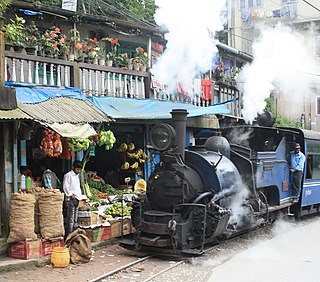
The Darjeeling Himalayan Railway, also known as the DHR or the Toy Train, is a 610 mm gauge railway that runs between New Jalpaiguri and Darjeeling in the Indian state of West Bengal. Built between 1879 and 1881, it is about 88 km (55 mi) long. It climbs from about 100 m (330 ft) above sea level at New Jalpaiguri to about 2,200 m (7,200 ft) at Darjeeling, using six zig zags and three loops to gain altitude. Ghum station is situated at an altitude of 2,258 metres (7,407 ft). Six diesel locomotives handle most of the scheduled service, with daily tourist trains from Darjeeling to Ghum – India's highest railway station – and the steam-hauled Red Panda service from Darjeeling to Kurseong. Steam-enthusiast specials are hauled by vintage British-built B-Class steam locomotives. The railway's headquarters are at Kurseong.

Namchi is a city and the administrative headquarter of the Namchi district in the Indian state of Sikkim. The appellation Namchi means Sky (Nam) High (Chi) in Sikkimese.
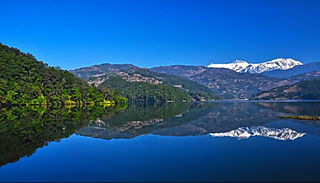
Kaski District, a part of Gandaki Province, is one of the seventy-seven districts of Nepal. The name is disambiguated from Kaskikot, the ancient Kaski Kingdom.
Darjeeling Gorkha Hill Council, also once known for a short period of time as Darjeeling Gorkha Autonomous Hill Council, was a semi-autonomous body that looked after the administration of the hills of Darjeeling District in the state of West Bengal, India. DGHC had three subdivisions under its authority: Darjeeling, Kalimpong, and Kurseong and some areas of Siliguri subdivision.

Bhutia Busty monastery or Karma Dorjee Chyoling monastery is a Buddhist monastery located in Bhutia Busty, Darjeeling district, India. It belongs to the Red Sect of Buddhist Lamas.

Tiger Hill is a mountain located in Darjeeling, in the Indian State of West Bengal. It has a panoramic view of Mount Everest and Mount Kanchenjunga together.

Happy Valley Tea Estate is a tea garden in Darjeeling district in the Indian state of West Bengal. Established in 1854, it is Darjeeling's second oldest tea estate. Spread over 177 hectares, it is situated at a height of 2,100 metres (6,900 ft) above sea level, 3 kilometres (1.9 mi) north of Darjeeling, and employs more than 1500 people.
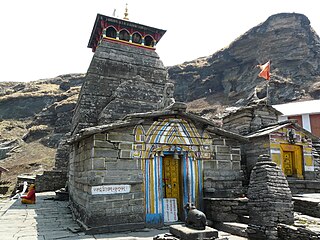
Tungnath Temple (IAST:tuņgnāth) is one of the highest Shiva temples in the world and is the highest of the five Panch Kedar temples located in the Rudraprayag district, in the Indian state of Uttarakhand. The Tungnath mountains form the Mandakini and Alaknanda river valleys. It is located at an altitude of 3,680 m (12,073 ft), and just below the peak of Chandrashila. It has a rich legend linked to the Pandavas, heroes of the Mahabharata epic.
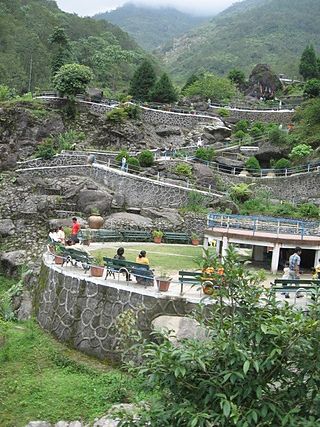
The Rock Garden at Chunnu Summer Falls and Ganga Maya Park are recently added tourist attractions in the hilly town of Darjeeling in the state of West Bengal, India. It is a showpiece meant to lure people to Darjeeling after political agitations disrupted tourism in the 1980s. There is another rock garden in Darjeeling known as Sir John Anderson Rock Garden, which is part of Lloyd's Botanical Garden.

The culture of Darjeeling, India, is diverse and has a regional distinctness.
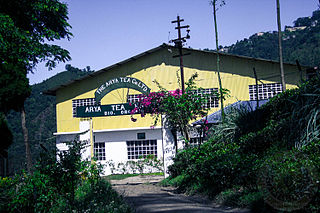
Arya Tea Estate is a tea garden in the Darjeeling Pulbazar CD block in the Darjeeling Sadar subdivision of the Darjeeling district in West Bengal, India

West Bengal is a state in the eastern region of India and is the nation's fourth-most populous state. The state capital is Kolkata. The state encompasses two broad natural regions: the Gangetic Plain in the south and the sub-Himalayan and Himalayan area in the north. The tourism in West Bengal is maintained by WBTDCL, a state government owned enterprise.
Uttarakhand is a state in the northern part of India. It is often referred to as the "Devbhoomi" due to its religious significance and numerous Hindu temples and pilgrimage sites found throughout the state. As a result, religious tourism forms a major portion of the tourism in the state. Uttarakhand is known for the natural environment of the Himalayas. 2019 Tourist Arrivals Domestic – 40,000,000 per/year and Foreigner – 150,000 per year. Tourism business in Uttarakhand generated ₹ 23,000 crores during 2013–14.

Northeast India consists of eight states: Arunachal Pradesh, Assam, Manipur, Meghalaya, Mizoram, Nagaland, Sikkim and Tripura. Tourism in this area is based around the unique Himalayan landscape and culture distinct from the rest of India.

The Mahakal Temple or Mahakal Mandir. Translation: The master of Kaal[time]) is a sacred Hindu temple located in Darjeeling, West Bengal, India, dedicated to the Hindu god Shiva, the third god in the Hindu triumvirate. The temple was built in 1782 by Lama Dorjey Rinzing and is perched atop the Observatory Hill and is an amalgamation of Hindu and Buddhist religions. It is a religious site where both religions coexist harmoniously.

Chowrasta "Intersection" lit. where four roads meet) is a historical public square in the Victorian era hill resort town of Darjeeling in the state of West Bengal, India. Located in the heart of the town it was the fashionable place of assembly for residents and visitors in the 18th century. Chowrasta is situated on the ridge of the Darjeeling hill range and is now a center of tourist attraction and a popular spot for the residents to assemble.
Lebong & Mineral Spring Tea Garden is a village in the Darjeeling Pulbazar CD block in the Darjeeling Sadar subdivision of the Darjeeling district in the state of West Bengal, India.























